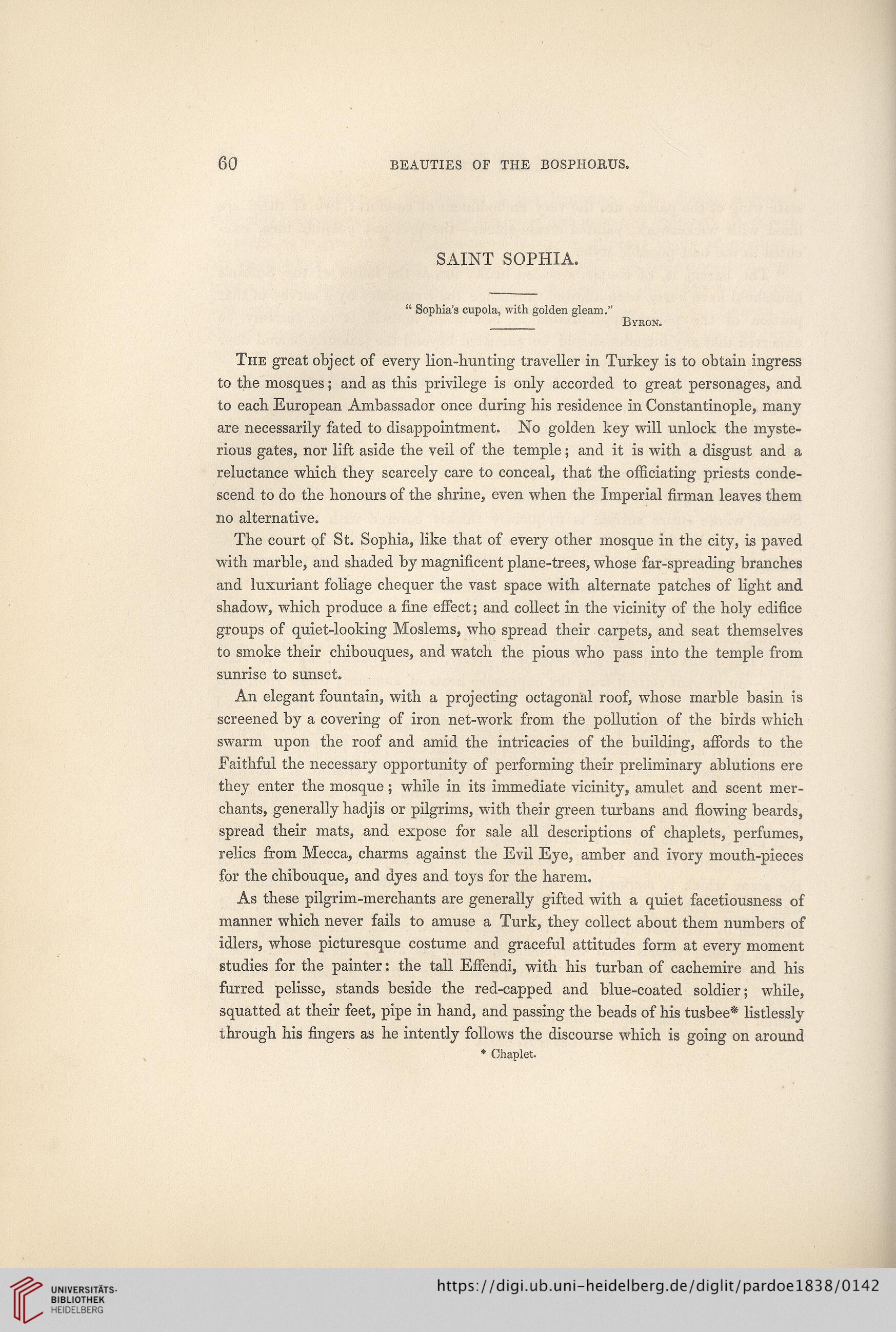60
BEAUTIES OF THE BOSPHORUS.
SAINT SOPHIA.
“ Sophia's cupola, with golden gleam."
Byron.
The great object of every lion-hunting traveller in Turkey is to obtain ingress
to the mosques; and as this privilege is only accorded to great personages, and
to each European Ambassador once during his residence in Constantinople, many
are necessarily fated to disappointment. No golden key will unlock the myste-
rious gates, nor lift aside the veil of the temple; and it is with a disgust and a
reluctance which they scarcely care to conceal, that the officiating priests conde-
scend to do the honours of the shrine, even when the Imperial firman leaves them
no alternative.
The court of St. Sophia, like that of every other mosque in the city, is paved
with marble, and shaded by magnificent plane-trees, whose far-spreading branches
and luxuriant foliage chequer the vast space with alternate patches of light and
shadow, which produce a fine effect; and collect in the vicinity of the holy edifice
groups of quiet-looking Moslems, who spread their carpets, and seat themselves
to smoke their chibouques, and watch the pious who pass into the temple from
sunrise to sunset.
An elegant fountain, with a projecting octagonal roof, whose marble basin is
screened by a covering of iron net-work from the pollution of the birds which
swarm upon the roof and amid the intricacies of the building, affords to the
Faithful the necessary opportunity of performing their preliminary ablutions ere
they enter the mosque ; while in its immediate vicinity, amulet and scent mer-
chants, generally hadjis or pilgrims, with their green turbans and flowing beards,
spread their mats, and expose for sale all descriptions of chaplets, perfumes,
relics from Mecca, charms against the Evil Eye, amber and ivory mouth-pieces
for the chibouque, and dyes and toys for the harem.
As these pilgrim-merchants are generally gifted with a quiet facetiousness of
manner which never fails to amuse a Turk, they collect about them numbers of
idlers, whose picturesque costume and graceful attitudes form at every moment
studies for the painter: the tall Effendi, with his turban of cachemire and his
furred pelisse, stands beside the red-capped and blue-coated soldier; while,
squatted at their feet, pipe in hand, and passing the beads of his tusbee* listlessly
through his fingers as he intently follows the discourse which is going on around
* Chaplet.
BEAUTIES OF THE BOSPHORUS.
SAINT SOPHIA.
“ Sophia's cupola, with golden gleam."
Byron.
The great object of every lion-hunting traveller in Turkey is to obtain ingress
to the mosques; and as this privilege is only accorded to great personages, and
to each European Ambassador once during his residence in Constantinople, many
are necessarily fated to disappointment. No golden key will unlock the myste-
rious gates, nor lift aside the veil of the temple; and it is with a disgust and a
reluctance which they scarcely care to conceal, that the officiating priests conde-
scend to do the honours of the shrine, even when the Imperial firman leaves them
no alternative.
The court of St. Sophia, like that of every other mosque in the city, is paved
with marble, and shaded by magnificent plane-trees, whose far-spreading branches
and luxuriant foliage chequer the vast space with alternate patches of light and
shadow, which produce a fine effect; and collect in the vicinity of the holy edifice
groups of quiet-looking Moslems, who spread their carpets, and seat themselves
to smoke their chibouques, and watch the pious who pass into the temple from
sunrise to sunset.
An elegant fountain, with a projecting octagonal roof, whose marble basin is
screened by a covering of iron net-work from the pollution of the birds which
swarm upon the roof and amid the intricacies of the building, affords to the
Faithful the necessary opportunity of performing their preliminary ablutions ere
they enter the mosque ; while in its immediate vicinity, amulet and scent mer-
chants, generally hadjis or pilgrims, with their green turbans and flowing beards,
spread their mats, and expose for sale all descriptions of chaplets, perfumes,
relics from Mecca, charms against the Evil Eye, amber and ivory mouth-pieces
for the chibouque, and dyes and toys for the harem.
As these pilgrim-merchants are generally gifted with a quiet facetiousness of
manner which never fails to amuse a Turk, they collect about them numbers of
idlers, whose picturesque costume and graceful attitudes form at every moment
studies for the painter: the tall Effendi, with his turban of cachemire and his
furred pelisse, stands beside the red-capped and blue-coated soldier; while,
squatted at their feet, pipe in hand, and passing the beads of his tusbee* listlessly
through his fingers as he intently follows the discourse which is going on around
* Chaplet.




